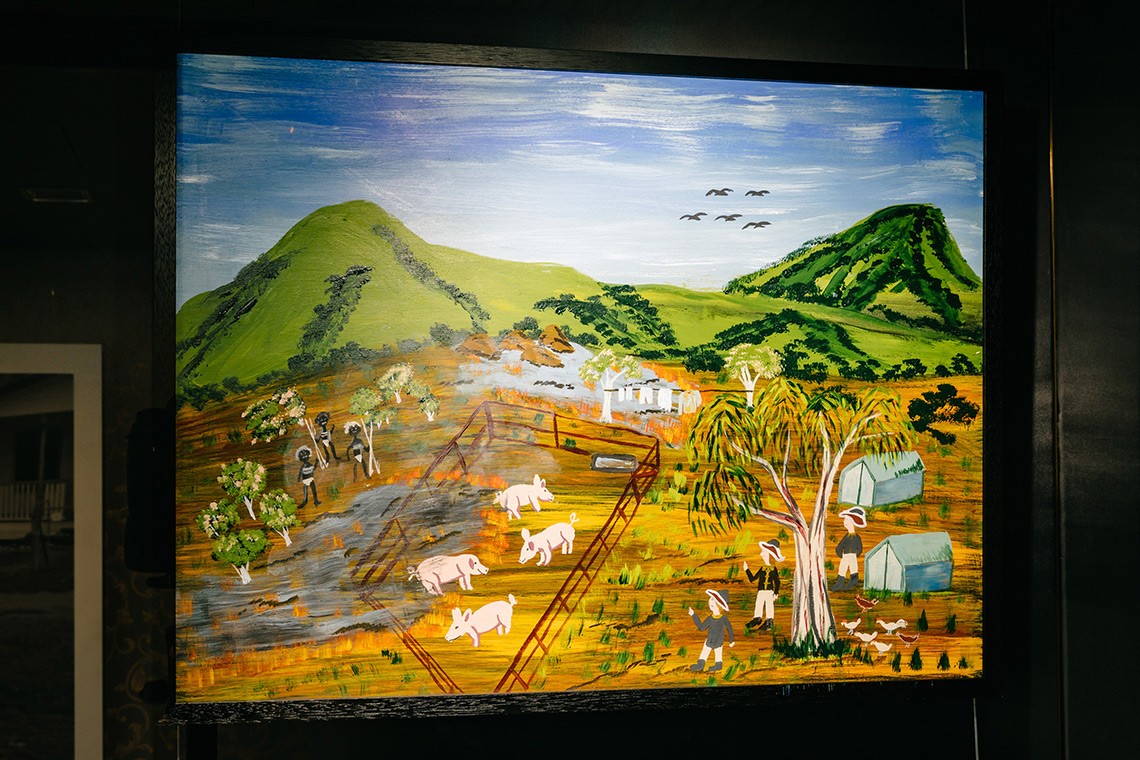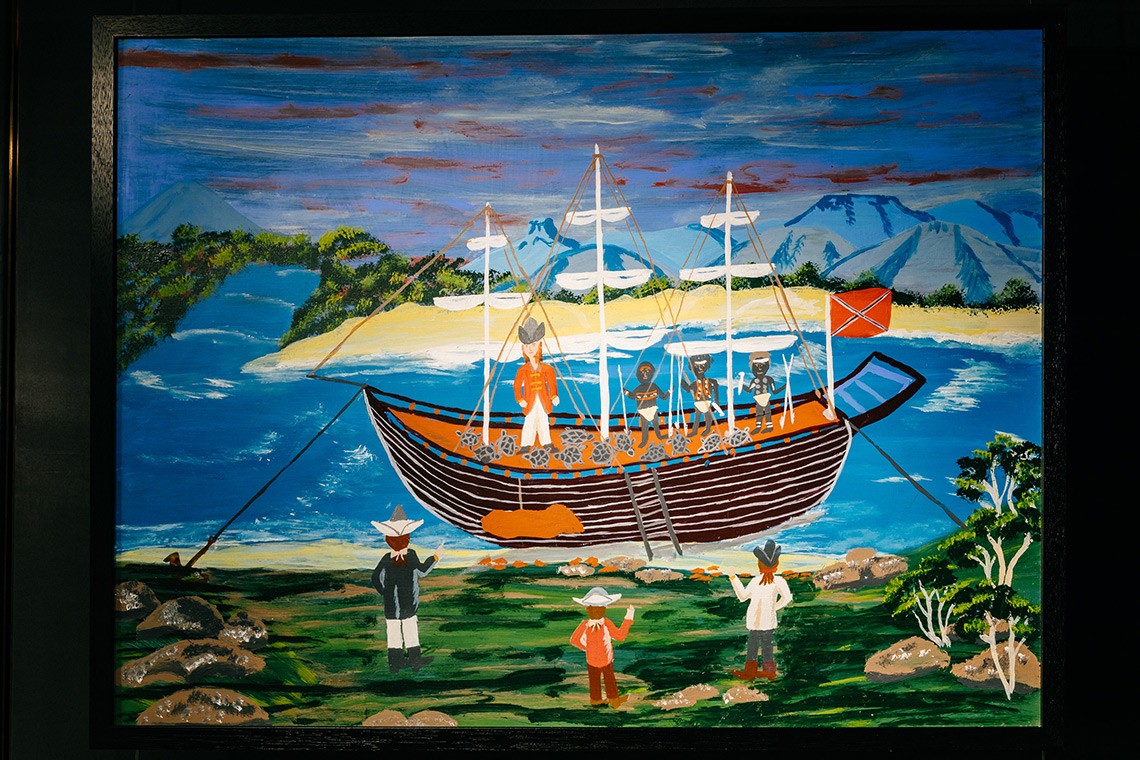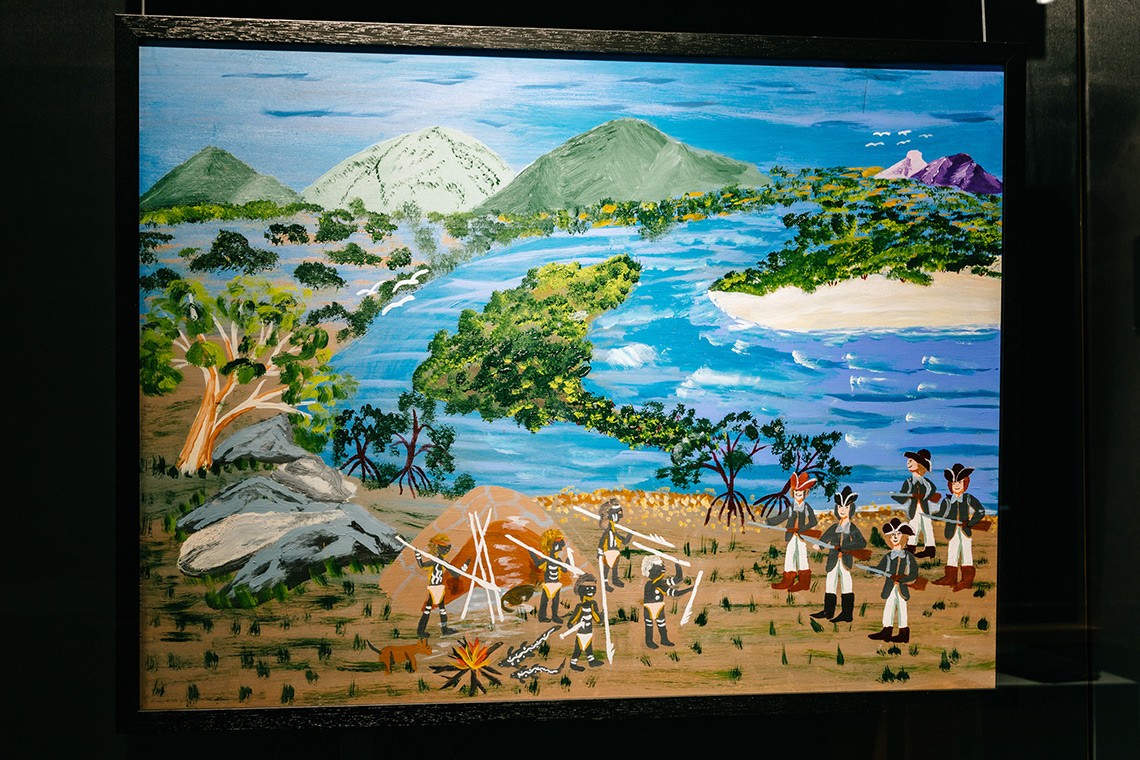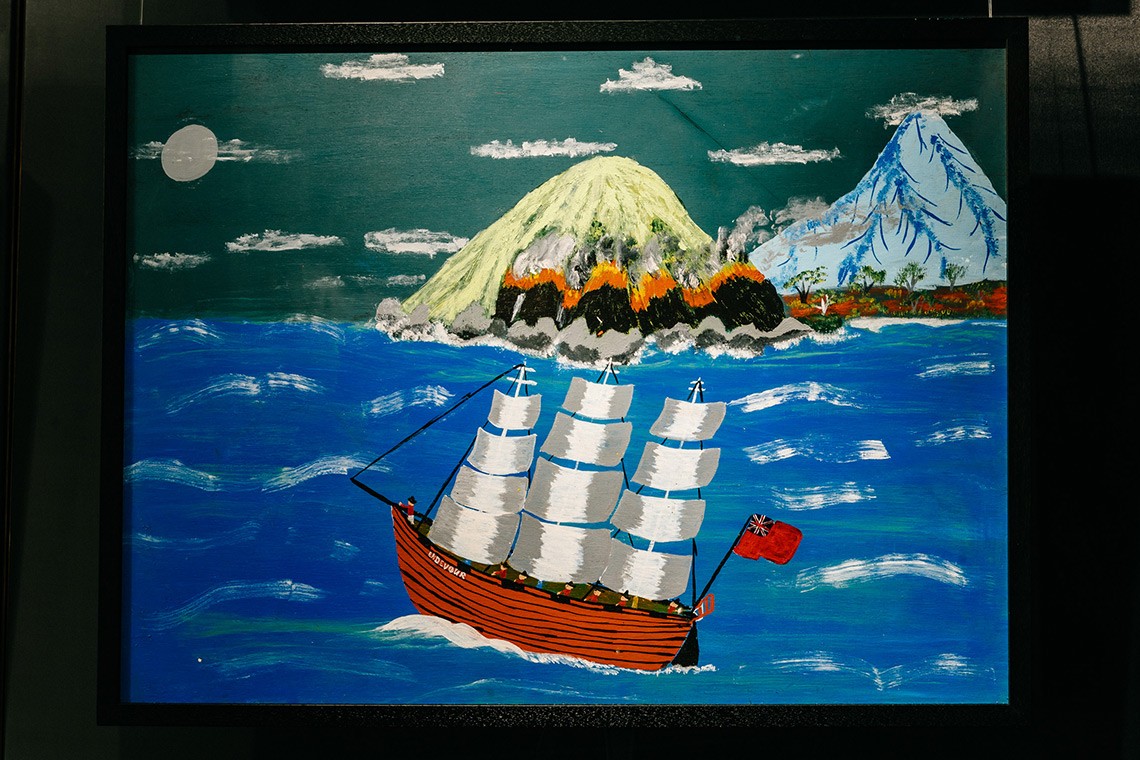Talbot Family Treasures Wall: Wanda Gibson artworks
By Tom Jordan, Queensland Memory | 24 September 2021
On display at the State Library of Queensland's Talbot Treasures wall are four artworks by Guugu Yimithirr artist Wanda Gibson, part of the Nukgal Wurra clan. Titled Burning The Pigs, Twelve Turtles, Defending Our Camp and Sail Away, they tell the story of the seven week period in 1770 where Lieutenant James Cook and the crew of the Endeavour were stranded at the mouth of the Wabalumbaal Birri, or Endeavour river as it is widely known as today.
As many of the histories we read today are told from the perspective of the Lieutenant and his crew, Wanda Gibson decided to address this imbalance by retelling these stories through the lens of the oral history-telling tradition developed by First Nations peoples over thousands of years.

Burning the Pigs, 2020, 32688 Wanda Gibson artworks, John Oxley Library, State Library of Queensland. - ‘Cook brought with him pigs and livestock on his boat. On the first day he landed, he set up a pen on the beach to keep the pigs in. The Bama did not know what those pigs were, or what he was doing. So one day, the Bama set the pig pen on fire and burned it down. Cook didn’t like that. He got angry and fired guns at the Bama. Some of the pigs escaped the pen and ran into the bush. We still hunt and eat them today.’
Wanda was born in 1946 in Woorabinda, west of Rockhampton in the midst of the Second World War. As the wartime government was untrusting of the Lutheran missions dotted across the Cape York peninsula, many missionaries and the aboriginal families who lived on the missions were interned further south for the duration of the war. In 1950, the Lutheran mission in Hope Valley was re-established, and Wanda and her family were moved back up north to live in the new settlement of Hope Vale. A fluent Guugu Yimithirr speaker and part of the Gamba Gamba (senior women) group at the Hope Vale art centre, Wanda depicts the scenes in these paintings from the oral histories she was taught from a very young age:
The Gamba Gamba draw on traditional Guugu Yimithirr Warra culture and contemporary history in the development of their artworks, and they hold deep cultural and linguistic knowledge in their community and are passionate about passing on their stories and knowledge to the younger generation.

Twelve Turtles, 2020, 32688 Wanda Gibson artworks, John Oxley Library, State Library of Queensland. - ‘Cook and his men were hungry. They went out and hunted turtles. They were easy pickings. However, Cook didn’t understand our law. The turtle is very sacred to us. There are many cultural protocols around the hunting and butchering of the animal. Bama saw twelve turtles on board Cook’s ship. They got very upset and angry and even tried to throw the turtles over the side of the ship but Cook’s men stopped them. This is when the trouble started. Bama came back to Cook’s camp with spears and weapons. Cook’s men fired shots and some Bama were hit, but not killed. It was a very scary situation. There could have been serious bloodshed.’

Defending Our Camp, 2020, 32688 Wanda Gibson artworks, John Oxley Library, State Library of Queensland. - ‘Tensions ran high between the Bama and Cooks men at first. The Bama thought that Cook’s men might be evil spirits, and Cook’s men were scared of the Bama and they wanted to hurt us.
During the seven weeks Cook spent repairing the Endeavour for their voyage back to Europe, Cook and others such as Joseph Banks and Sydney Parkinson also spent time engaging in dialogue with the Guugu Yimithirr people. At first this exchange was peaceful, with the Guugu Yimithirr offering to help the stranded sailors by helping them find food and the materials needed to repair the reef damaged ship. However, after the scene depicted in Twelve Turtles the interactions become more hostile. In the laws and culture of the Guugu Yimithirr people, only taking what you need from nature is very important, as caring for the natural ecosystem surrounding them was paramount to their continued survival. When the Guugu Yimithirr saw that the crew had captured an unnecessary number of the slow-breeding turtles, a pillar of the reef ecosystem, they decided to board the ship and throw the turtles back overboard to ensure the long-term survival of the species. Not understanding the laws and practice of the Aboriginal people, the sailors, thinking the Guugu Yimithirr were stealing the turtles, retaliated with violence and gun powder, injuring some.

Sail Away, 2020, 32688 Wanda Gibson artworks, John Oxley Library, State Library of Queensland. - ‘On the night that Cook and his crew left our country, the Bama set fire to the land and to the mountains around the area to try and get rid of the bad spirits. This tradition is still something we do today - some people call it a ‘smoking ceremony’. The Bama thought that they were gone and would not come back. They were wrong. I wish they knew then what we know now.’
This violence continued for a number of days until eventually, sick of the blood that had been shed on his land, a Guugu Yimithirr elder stood in front of the crew on the rocky beach, holding a spear with a broken tip: a symbol of peace and to the end of the fighting. Cook and the Guugu Yimithirr people were able to come to a cultural understanding through the following dialogue, marking the first reconciliation between the Europeans and the Aboriginal people.
In 2019 and 2020, State Library held Spoken: Celebrating Queensland Languages, an exhibition showcasing the incredible diversity in Indigenous languages across the state. As Guugu Yimithirr was one of the first languages recorded by Sydney Parkinson on the Endeavour, local words like Gangurru, or Kangaroo, were the first Aboriginal words to travel back to England with the crew.
Harold Ludwick, a Bulgan Warra man from Guugu Yimithirr country, tells the story of reciprocity and reconciliation of the Endeavour and the Guugu Yimithirr people in its entirety in this video filmed for the Spoken exhibition.
Harold Ludwick provides a shore-to-ship account of the first interactions between the crew of the Endeavour and the Guugu Yimithirr people.
To find out more, we welcome you to discover Queensland languages with our Indigenous languages map of Queensland, an interactive map aimed to highlight the diversity and wide-range of Aboriginal and Torres Strait Island languages. Learn more about State Library and Aboriginal and Torres Strait Islander culture and stories here.
You can see Wanda Gibson's artwork and many other treasures at the Talbot Family Treasures Wall, level 4, open daily 10am-5pm.
Comments
Your email address will not be published.
We welcome relevant, respectful comments.